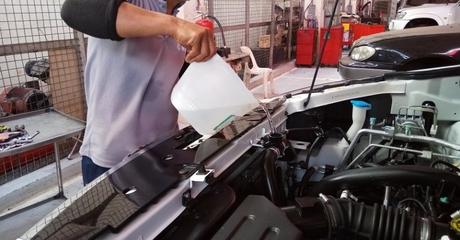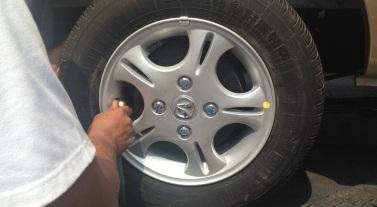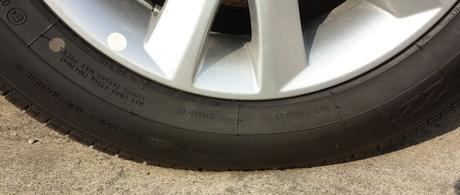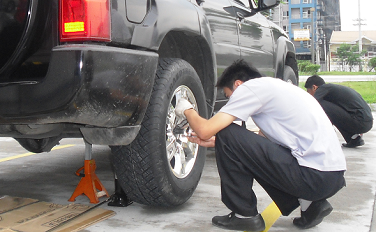
Car maintenance is important for every car owner and most importantly for the driver. As driver one must know these basic car maintenance and repair skills.
1. How to check tire pressure: Tire pressure is very important for safe driving. Besides being a potential cause for complete tire failure, underinflated tires increase braking distance, raise the risk of hydroplaning, and can even affect your ability to steer correctly. Anyone can check their car’s tire pressure by using a tire pressure gauge. Tire pressure gauges are sold at most major retailers, such as Wal-Mart and Target, or at auto maintenance stores, like AutoZone and O’Reilly Auto Parts.
 How to Check Tire Air Pressure
How to Check Tire Air PressureThe tire tread life will be reduced if the tire air pressure of your car is below the car manufacturer tire air pressure specified on your car owner’s manual.
Learn more: How to Check Tire Air Pressure
Tire pressure is measured in pounds per square inch (psi). Most compact vehicles require tires to be filled at 32 psi. However, you should check your owner’s manual or the sticker on the side of the driver’s side door to see how many pounds per square inch your car’s tires need. Once you know the required psi for your car, use your tire pressure gauge to measure your tires’ psi. If you need more air, go to a gas station or car repair shop with an air machine and fill them up to the required psi.

Be sure not to overinflate your tires, though, because they will have less contact with the road, creating a very bumpy ride. Like underinflated tires, overinflated tires also wear down quicker. If your tires are overinflated, use the mechanism on the air machine that allows air to escape
2. How to refill windshield washer fluid tank: If the windshield washer fluid tank needs to be refilled, you can either use water or washer fluid. Like tire pressure gauges, washer fluid is sold at most retailers and at auto maintenance stores. Once you have your water or washer fluid, simply lift the hood and look for the vessel with the windshield washer symbol on it. Screw off the cap, fill it up and reseal. Although it isn’t necessary, you can use a funnel to prevent spills.
3. How to install new windshield wipers: Changing windshield wipers is very easy. If you need assistance the first time, go to an auto maintenance store and ask the store clerk if they wouldn’t mind showing you the ropes. You will use a manual to look up the make, model and year of your vehicle, which will then tell you what type of windshield wiper blade you need to buy. Directions to change them out are on the packaging. Some owner’s manuals also contain directions.
 Changing Windshield Wipers
Changing Windshield WipersWindshield wiper blades sometimes chatter during operation because of the presence of wax and other materials on the windshield or on the wiper blades itself. This means that both parts are needed to be cleaned.
Learn more: Changing Windshield Wipers
4. How to change headlight or brake light bulbs: As with changing your windshield wiper blades, you will use a manual located in the car part aisle to look up the type of bulbs your car needs. If you are changing a bulb at the front of your car, lift your hood to gain access to the headlight. If you are changing a bulb at the back of your car, open the trunk to gain access to the brake lights. For step-by-step help, use your owner’s manual, which contains more detailed information for your car.
5. How to charge up to a dead battery: If you don’t already have jumper cables in your car, go buy them today. You never when you or someone nearby may need them. Although your owner’s manual should contain a section on how to charge your car’s battery with jumper cables, here’s a simple explanation…
First, inspect the dead battery. If it looks damaged, do not jump start it. If it looks normal, find another driver who is willing and able to move their vehicle near yours (but not touching yours). Lift the hood of both cars, make sure both cars are turned off and engage the parking brake on both cars. Attach the positive (red) clamp to the positive node on the dead battery, and then attach the other positive (red) clamp to the positive node on the good battery. Next, attach the negative (black) clamp to the negative node on the good battery and the other negative (black) clamp to a metal section of the dead car’s engine that is away from the battery. Make sure everyone is away from both car’s batteries, and start the engine of the good car. Allow it to run for at least one minute, and then try to start the engine of the dead car. If, after two or three tries, the dead car won’t start, turn off both cars’ engines, remove the cables and call for service.
6. How to change a flat tire: Although it isn’t difficult to learn how to change a tire, there are quite a few steps that can’t be easily explained in writing. First things first; if you aren’t strong enough to lift your spare tire, you probably won’t be able to change a flat tire. However, don’t let this stop you from at least learning how to do it, because you never know when the skill will come in handy. To learn, find someone you know personally who is willing to teach you or ask your local car repair shop if they wouldn’t mind taking the time to show you how. Although there are videos on the internet that teach how to change a tire, it is still best to learn by actually doing it. If you ever need to use this skill and can’t remember every step, most owners’ manuals contain step-by-step instructions.
 How to Change Flat Tire
How to Change Flat TirePark the car on a flat surface with a solid foundation. Ensure that the car is parked on a flat surface and that the ground can support the weight of the car. Put a tire stopper on the tire opposite the flat tire. Use a block or a rock as tire stopper.
Learn more: How to Change Flat Tire
About the Author:Sarah Montgomery is a writer and lover of all things automotive. Her dad first taught her how to change the oil in a car when she was just eight, and now she enjoys writing articles about purchasing, insuring and maintaining your vehicle for www.CarInsuranceQuotes.org. Sarah loves to get responses from her readers, so please feel free to leave your questions or comments for her below!
